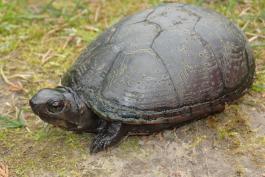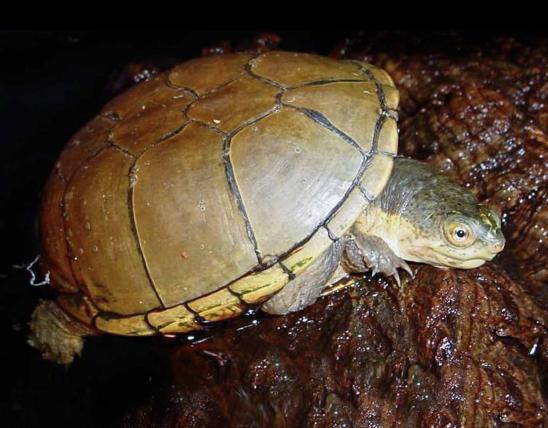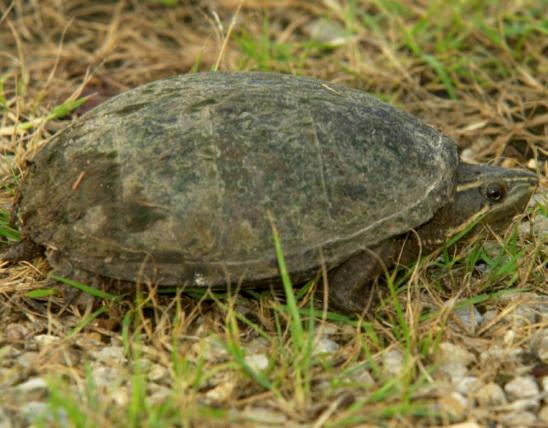
The Mississippi mud turtle is a small, dark turtle with yellow stripes along the side of the head and neck. It occurs in the swamps of southeastern Missouri. The carapace (upper shell) is brown, dark brown, or nearly black (especially when the shell is wet). The plastron (lower shell) is yellow brown with brown extending along the margins of the scutes (shell scales) and along the center. The exposed fleshy parts are normally gray brown. On most individuals, there are usually 2 yellow stripes along the side of the head and neck, but these may appear as a series of spots rather than stripes. On lighter-colored specimens, small, irregular yellow spots may cover parts of the head and neck. Adult males can be distinguished from females by concave plastrons and by longer, thicker tails terminating in a clawlike process.
The ninth marginal scute on the carapace is not enlarged as it is in the yellow mud turtle, and this is a key feature for telling Missouri's two mud turtles apart.
As with other members of the musk and mud turtle family, this species gives off an offensive, musky odor when captured.
Similar species: The closest relative in Missouri is the yellow mud turtle (K. flavescens flavescens), which is restricted to a few southwestern corner, some locations in west-central Missouri (the Kansas City area), and a few marshes in far northeastern Missouri. Thus our two mud turtles occur in very different parts of the state. A key character for distinguishing the yellow mud turtle from other members of its family is the height of the ninth marginal scale on the carapace. This scale is much higher toward the middle of the upper shell than the eighth marginal scale.
Compared to the eastern musk turtle (in genus Sternotherus), mud turtles (genus Kinosternon) have larger plastrons (lower shells), and the front and hind parts are both movable.
Adult upper shell length: 2¾–4¾ inches; occasionally to 5 inches.

Mainly restricted to the counties of the Mississippi Alluvial Basin of southeastern Missouri. Because in Missouri, this species only occurs in the Bootheel and some counties along the Arkansas border in southeastern Missouri, our state’s mud turtles are quite separated geographically.
Habitat and Conservation
This species lives in or near permanent and semipermanent water, including swamps, sloughs, oxbow lakes, ponds, ditches, and canals. It is most often observed in vegetated, shallow water with a soft bottom, and it seems to avoid flowing rivers. Although well equipped for an aquatic existence, this mud turtle spends as much time wandering about on land as it does in water.
In Missouri, it is active from April to October. It is commonly seen crossing roads in southeastern Missouri during late spring into fall, especially following rains. Although this species will overwinter in the mud at the bottom of a wetland, many individuals move overland — sometimes considerable distances, to nearly 2,000 feet—to bury themselves under soil and leaves. In Oklahoma, they are known to overwinter in burrows at depths of 4–6 inches. In Missouri, the Mississippi mud turtle probably enters its overwintering retreat in late October. A study in Illinois found that this species spent a considerable amount of time in underground burrows.
Food
The Mississippi mud turtle eats a wide variety of aquatic animals and plants. The diet includes insects, crayfish, mussels, and various amphibians.
Status
Although the population of this species seems stable in our state, it is of utmost importance to preserve its natural habitats, especially remaining cypress swamps, oxbow lakes, and sloughs surrounded by bottomland forest.
Life Cycle
In Missouri, courtship and mating of this species apparently occurs from late April into June. Females lay 1–6 eggs from May into July. There may be up to 3 clutches per season. Eggs are normally laid in well-drained, sandy soil. Incubation time ranges from 90 to 119 days. Females reach maturity at 6–8 years of age. Lifespan in the wild may be from 20 to 50 years. This species probably enters overwintering retreats in late October and emerges again in April.
Human Connections
The wetlands inhabited by these turtles are also home to many species of fish and waterfowl that are pursued by anglers and hunters. Protecting the habitat for these turtles helps fishers and duck hunters, too.
Turtles are important to humans symbolically. They represent patience, longevity, wisdom, and perseverance. They figure into hundreds of ancient myths worldwide. Each species has a unique character that humans can appreciate. Native Americans used turtle shells to make rattles.
The state of Missouri is where four ecological regions intersect. Within our human-made political borders, we have edges of the glaciated Central Dissected Till Plains, the Ozark Highlands, the Osage Plains, and the Mississippi Alluvial Basin. This species' global range extends southwest to eastern Oklahoma and eastern Texas, and south to southwestern Mississippi and all of Louisiana. So it's fair to ask about the "importance" of Missouri's populations, which can seem marginal compared to the overall range. Indeed, there are a number of interesting plants and animals that occur only in the corners of Missouri. Please keep in mind that populations on the edge of a species' overall range often are found to be distinct genetically from the rest, sometimes to the point where they are eventually considered separate subspecies or species. Also, populations on the edge of the range may have a special resistance to disease, or other helpful genetic traits. And given a changing climate, they may be in a geographic position to thrive while populations elsewhere may decline. Another point is that all species occurring within our borders are part of our state's rich wildlife heritage, and it's up to us to care for them.
Ecosystem Connections
This species is a predator of small aquatic animals, but it is also a prey species: There are many other animals that consume these turtles, especially the eggs and hatchlings.
The American mud and musk turtle family (Kinosternidae) occurs only in North and South America and is made up of rather small, dull-colored turtles. Species within this family occur from Canada to Argentina and have been classified into 25 species in five genera. Three species, representing two of the genera, occur in Missouri: the yellow mud turtle (Kinosternon flavescens), Mississippi mud turtle (K. subrubrum hippocrepis), and eastern musk turtle (nicknamed the “stinkpot,” Sternotherus odoratus). All members of this family possess small scent glands along the seam between the upper shell and lower shell. When captured or roughly handled, musk and mud turtles produce a strong, unpleasant smell.


























